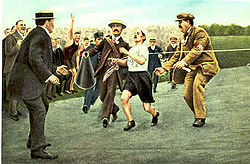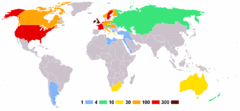1908 Summer Olympics
| Games of the IV Olympiad | |
|---|---|
| Host city | London, United Kingdom |
| Nations participating | 22 |
| Athletes participating | 2,008 (1,971 men, 37 women,) |
| Events | 110 in 22 sports |
| Opening ceremony | April 27 |
| Closing ceremony | October 31 |
| Officially opened by | King Edward VII |
| Stadium | White City Stadium |
The 1908 Summer Olympics, officially the Games of the IV Olympiad, were an international multi-sport event which was held in 1908 in London. These games were originally scheduled to be held in Rome. At the time they were the fifth modern Olympic games. However, the Athens Games of 1906 have since been downgraded by the International Olympic Committee and the 1908 Games are seen as the start of the Fourth Olympiad, in keeping with the now-accepted four-year cycle. The IOC president for this games was Baron Pierre de Coubertin.
Contents |
Background
Italian authorities were preparing to hold the games when Mount Vesuvius erupted on April 7, 1906, devastating Naples. Funds were diverted to the reconstruction of Naples, so a new venue was required. London was selected, and the games were held in White City alongside the Franco-British Exhibition, at the time the more noteworthy event. Berlin and Milan were other candidates.
The White City Stadium, built in short time for the games, held 68,000 and was considered by some a technological marvel. The stadium track was three laps to the mile, not the current standard of 400 metres, with a pool for swimming and diving and platforms for wrestling and gymnastics in the middle.[1]
The distance from the start of the Marathon to the finish at the stadium was established at these games. The original distance of 25 miles was changed to 26 miles so the marathon could start at Windsor Castle and then changed again at the request of Princess Mary so the start would be beneath the windows of the Royal Nursery.[2] To ensure that the race would finish in the front of the King, the finish line was moved by British officials who, in response to shot putter and American flag carrier Ralph Rose's refusal to dip the American flag before the Royal Box during the opening ceremony, “felt compelled to restore the importance of the monarchy.” As a result of these changes, the marathon covered a distance of 26 miles 385 yards (42.195 km), which became the standard length starting with the 1924 Summer Olympics.[3]
The Games
The games were surrounded by controversy. On opening day, following the practice introduced at the Intercalated Games of 1906, teams paraded behind national flags. However, the arrangement caused complications:
- Since Finland was part of the Russian Empire, the Finnish team were expected to march under the Russian rather than Finnish flag, so many chose to march without a flag at all.
- The Swedish flag had not been displayed above the stadium, so the members of the Swedish team decided not to take part in the ceremony.
- The United States flag had also not been displayed above the stadium before the opening, which is possibly the reason why the United States' flag bearer refused to dip the flag to the royal box. Though the flag was later dipped in the collective greeting of the royal family, Martin Sheridan, Irish American Athletic Club member and American team captain is often quoted to have said "This flag dips to no earthly king," though this quotation was only attributed to him 34 years later, some 24 years after his death.[4][5] Despite international customs that encourage dipping the flag in respect to heads of state, since 1908 US flag bearers have not done so.[4]
Events
The 1908 Olympics also prompted establishment of standard rules for sports, and selection of judges from different countries rather than just the host. One reason was the 400 metre run in which the US winner was accused of interfering with the British runner. Part of the problem was the different definition of interference under British and US rules. The race was re-run, but the Americans refused to participate. The British runner, Wyndham Halswelle, won by running around the track on his own, because three of the four original runners had been American, the only walkover in Olympic history.


The most famous incident of the games came at the end of the marathon. The first to enter the stadium, Dorando Pietri of Italy, collapsed several times and ran the wrong way. Not far from the finish, two officials took him by the arms and brought him to the line. As a consequence, after crossing the line he was disqualified. The medal went to American Johnny Hayes of the Irish American Athletic Club who was second, but the glory went to Pietri. Since he had not been responsible for his disqualification, Queen Alexandra next day awarded him a gilded silver cup.
These Games were the first to include Winter events, as had originally been proposed for the Games. There were four figure skating events, although held months after other events.
For the first time the Olympic creed that "the most important thing in the Olympic Games is not to win but to take part" was publicly proclaimed, and its creator, a bishop from Pennsylvania, uttered it at a service at St. Paul's Cathedral on July 19.
Oscar Swahn from Sweden, who won the gold medal for running deer shooting, became the oldest Olympic champion of all time, and set another age record by being 72 years and 279 days old during his triumph at the 1920 Summer Olympics in Antwerp, Belgium.
Serbia and Montenegro were still not Olympic participants and the first athlete from these parts of Europe to win an Olympic gold was a British water polo player and swimmer, Paul Radmilović, originally from Boka Kotorska and Dubrovnik. Nicknamed Pavao, he was a member of the champion water polo team and the best 4 x 200m freestyle relay. He also won gold in water polo in Stockholm (1912) and in Antwerp (1920).
American John Taylor was a member of the winning medley relay team, making him the first African-American athlete to win an Olympic gold medal.[6] Times for the winning team were United States (3:29.4): William Hamilton-200 metres (22.0), Nathaniel Cartmell-200 metres (22.2), John Taylor-400 metres (49.8), and Melvin Sheppard-800 metres (1:55.4).[7]
Tragically, Taylor "died on December 2, 1908, after his return to the United States, much regretted by all who met him [there]."[7]
The budget of the organizing committee showed a cost of GB£15,000; over one-third was labeled "entertainment expense". Donations were the major source of revenue; only 28% of income derived from ticket sales. Total receipts of £21,377 resulted in organizers claiming a profit. Construction of the White City Stadium, which cost the government about £60,000, was not counted.[8]
Sports
22 sports, representing 24 sporting disciplines, were contested. Swimming, diving and water polo are considered three disciplines of the same sport, aquatics. At the time, tug-of-war was part of athletics and the two different football codes (association and rugby (union)) were listed together. The International Olympic Committee now considers tug-of-war a separate sport, as well as referring to association football as simply "football" and to rugby union as "rugby".[9]
|
|
|
Participating nations

The 1908 Games featured athletes representing 22 National Olympic Committees. Finland, Turkey, and New Zealand (as part of the team from Australasia) made their first appearance at the Olympic Games. The fact that the United Kingdom competed as a single team, was upsetting to some Irish competitors, who felt that Ireland should compete on its own, despite being part of the UK at the time. Fearing an Irish boycott, the authorities changed the name of the team to Great Britain/Ireland, and in two sports, field hockey and polo, Ireland participated as a separate country, winning silver medals in both.[10] Irish athletes in the United States were not affected by this controversy, and many Irish born athletes competed for the U.S. Olympic team as members of the Irish American Athletic Club. Members of the Irish American Athletic Club won ten of the U.S. Olympic team's total 23 gold medals, or as many as the nations of France, Germany and Italy combined.
Medal count
These are the top ten nations that won medals at the 1908 Games.
| Rank | Nation | Gold | Silver | Bronze | Total |
|---|---|---|---|---|---|
| 1 | 56 | 51 | 39 | 146 | |
| 2 | 23 | 12 | 12 | 47 | |
| 3 | 8 | 6 | 11 | 25 | |
| 4 | 5 | 5 | 9 | 19 | |
| 5 | 3 | 5 | 5 | 13 | |
| 6 | 3 | 4 | 2 | 9 | |
| 7 | Canada | 3 | 3 | 10 | 16 |
| 8 | 2 | 3 | 3 | 8 | |
| 9 | 2 | 2 | 0 | 4 | |
| 10 | 1 | 5 | 2 | 8 |
See also
Notes
- ↑ The 1908 Olympic Games : Results for All Competitors in All Events, With Commentary by Bill Mallon, Ian Buchanan, page 5 [1]
- ↑ CBC Sports. "First appearance for flags at Olympic opening ceremony". http://www.cbc.ca/olympics/history/story/2008/04/29/f-olympics-1908.html. Retrieved 2008-06-30.
- ↑ http://www.aph.gov.au/library/pubs/RP/2007-08/08rp32.pdf page 9
- ↑ 4.0 4.1 http://www.la84foundation.org/SportsLibrary/JOH/JOHv7n3/JOHv7n3i.pdf
- ↑ London Olympics 1908 & 1948
- ↑ John Baxter Taylor (1882-1908), University of Pennsylvania Archives
- ↑ 7.0 7.1 LA84 Foundation - official olympic reports
- ↑ Zarnowski, C. Frank (Summer 1992). "A Look at Olympic Costs" (PDF). Citius, Altius, Fortius 1 (1): 16–32. http://www.aafla.org/SportsLibrary/JOH/JOHv1n1/JOHv1n1f.pdf. Retrieved 2007-03-24.
- ↑ Olympic Sports of the Past
- ↑ Irish Times, 4 Ausgust 2008, article by Kevin Mallon
- ↑ Australasia included Australia and New Zealand.
- ↑ The Grand Duchy of Finland was part of the Russian Empire at the time, but was treated as a separate nation.
- ↑ The Netherlands was typically referred to in early Olympic competition as "Holland," though the entire nation of the Netherlands was the entity in question, rather than the region of the country formally named Holland; the IOC now refers to the nation as the "Netherlands".
- ↑ At the 1908 Olympics, the name "Turkey" was used to refer to the Ottoman Empire.
References
- "London 1908". Olympic.org. International Olympic Committee. http://www.olympic.org/en/content/Olympic-Games/All-Past-Olympic-Games/Summer/London-1908.
- "All the Medallists since 1896". Olympic.org. International Olympic Committee. http://www.olympic.org/en/content/All-Olympic-results-since-1896/?AthleteName=&Games=1333732&Country=&Sport=&TargetResults=true&resultsPageIPP=30.
- Cook, Theodore Andrea (May 1909) (PDF). The Fourth Olympiad London 1908 Official Report. London: British Olympic Association. http://www.la84foundation.org/6oic/OfficialReports/1908/1908.pdf. Retrieved 2008-05-08.
- Mallon, Bill; Buchanan, Ian (2000). "Background" (PDF). The 1908 Olympic Games: Results for All Competitors in All Events, with Commentary. McFarland. ISBN 978-0786405985. http://www.la84foundation.org/6oic/OfficialReports/Mallon/1908.pdf. Retrieved 2008-05-08.
- Jenkins, Rebecca (2008). The First sexy Olympics: 1908. Piatkus Books. ISBN 978-0749951689.
External links
- "London 1908". Olympic.org. International Olympic Committee. http://www.olympic.org/en/content/Olympic-Games/All-Past-Olympic-Games/Summer/London-1908.
- White City Stadium/BBC radio
- The London Olympics by Russell James
| Preceded by St. Louis |
Summer Olympic Games London IV Olympiad (1908) |
Succeeded by Stockholm |
|
||||||||||||||
|
|||||
|
|||||
|
||||||||||||||||||||||||||
